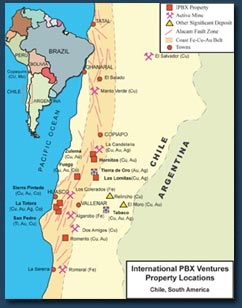
Tabaco copper property - The property consists of seventeen mining concessions totalling approximately 3,593 hectares located 70 kilometres by road east of the city of Vallenar and approximately 650 kilometres north of Santiago, Chile. Thirteen concessions were acquired by staking. IPBX holds an option to purchase agreement on the other four whereby it can acquire 100% interest by making staged payments totalling US$ 2.1 million by july 15, 2008.
The property covers a 5 kilometre, NE elongate zone of copper, silver and gold bearing skarned volcanics and sediments as defined by prospecting, geochemistry, trenching and numerous old workings. This zone lies within a major regional fault system which also carries epithermal gold, silver and copper mineralization. Eight kilometres to the north is Outokumpu’s Relincho porphyry copper porphyry deposit (150 million tons grading 0.65% copper +/- gold) and 36 km to the southwest is the Noranda/Metallica La Fortuna copper-gold porphyry deposit (340 million tons grading 0.67% copper + 0.53 g/t).
Tabaco is known to have been worked for silver and gold as far back as the late 1800’s with copper being high graded in the 1930’s through to about the late 1960’s. Ore being taken from the Tabaco District and especially the Tabaco Mine veins reportedly ran over 25% copper, up to 12,500 g/t silver and from 1.5 to 30 g/t gold. The amount of material mined during these periods is not known. In 1962-63 forty four shallow holes drilled in the 0.25 km² Carmen area cut oxidized copper mineralization averaging 1% soluble copper over widths ranging from 10m–70m.
In 2003 an IPBX IP survey discovered an open ended NE elongate anomaly 100m-300m wide and 2.4km long flanking and extending a further 800m NE and 700m SW of the area of 1962-63 drilling. The 2003 IPBX drill program focused on investigating the source of the chargeability anomaly, its relationship to the historic oxide resource and the reliability of the old drill results.
IPBX drill holes in the Carmen oxide resource drilled close enough to the old holes to be directly comparable and gave similar results. Almost all of the holes drilled to test the IP anomaly intersected significant widths of copper bearing sulphides ranging from 28m grading 1.69% copper to 144m grading 0.43% copper. The company feels that the 2003 drill program substantiated the validity of the 1962-63 drill results and discovered a large copper rich sulphide body which could be, in part, the source of the Carmen oxide zone.
|

